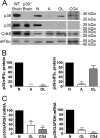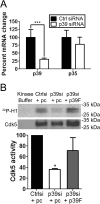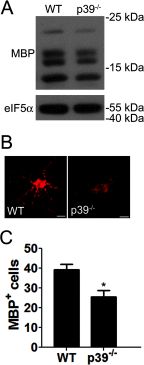p39, the primary activator for cyclin-dependent kinase 5 (Cdk5) in oligodendroglia, is essential for oligodendroglia differentiation and myelin repair
- PMID: 23645679
- PMCID: PMC3689949
- DOI: 10.1074/jbc.M113.453688
p39, the primary activator for cyclin-dependent kinase 5 (Cdk5) in oligodendroglia, is essential for oligodendroglia differentiation and myelin repair
Abstract
Cyclin-dependent kinase 5 (Cdk5) plays key roles in normal brain development and function. Dysregulation of Cdk5 may cause neurodegeneration and cognitive impairment. Besides the well demonstrated role of Cdk5 in neurons, emerging evidence suggests the functional requirement of Cdk5 in oligodendroglia (OL) and CNS myelin development. However, whether neurons and OLs employ similar or distinct mechanisms to regulate Cdk5 activity remains elusive. We report here that in contrast to neurons that harbor high levels of two Cdk5 activators, p35 and p39, OLs express abundant p39 but negligible p35. In addition, p39 is selectively up-regulated in OLs during differentiation along with elevated Cdk5 activity, whereas p35 expression remains unaltered. Specific knockdown of p39 by siRNA significantly attenuates Cdk5 activity and OL differentiation without affecting p35. Finally, expression of p39, but not p35, is increased during myelin repair, and remyelination is impaired in p39(-/-) mice. Together, these results reveal that neurons and OLs harbor distinct preference of Cdk5 activators and demonstrate important functions of p39-dependent Cdk5 activation in OL differentiation during de novo myelin development and myelin repair.
Keywords: Cyclin-dependent Kinase 5 (Cdk5); Differentiation; Gene Regulation; Glia; Myelin; Neurons; Oligodendroglia; p39.
Figures








Similar articles
-
p39 Is Responsible for Increasing Cdk5 Activity during Postnatal Neuron Differentiation and Governs Neuronal Network Formation and Epileptic Responses.J Neurosci. 2016 Nov 2;36(44):11283-11294. doi: 10.1523/JNEUROSCI.1155-16.2016. J Neurosci. 2016. PMID: 27807169 Free PMC article.
-
The Activators of Cyclin-Dependent Kinase 5 p35 and p39 Are Essential for Oligodendrocyte Maturation, Process Formation, and Myelination.J Neurosci. 2016 Mar 9;36(10):3024-37. doi: 10.1523/JNEUROSCI.2250-15.2016. J Neurosci. 2016. PMID: 26961956 Free PMC article.
-
Structural basis for the different stability and activity between the Cdk5 complexes with p35 and p39 activators.J Biol Chem. 2013 Nov 8;288(45):32433-32439. doi: 10.1074/jbc.M113.512293. Epub 2013 Sep 30. J Biol Chem. 2013. PMID: 24085300 Free PMC article.
-
The regulation of cyclin-dependent kinase 5 activity through the metabolism of p35 or p39 Cdk5 activator.Neurosignals. 2003 Sep-Oct;12(4-5):221-9. doi: 10.1159/000074624. Neurosignals. 2003. PMID: 14673209 Review.
-
Cdk5: a new player in pain signaling.Cell Cycle. 2006 Mar;5(6):585-8. doi: 10.4161/cc.5.6.2578. Epub 2006 Mar 15. Cell Cycle. 2006. PMID: 16552189 Review.
Cited by
-
p39 Is Responsible for Increasing Cdk5 Activity during Postnatal Neuron Differentiation and Governs Neuronal Network Formation and Epileptic Responses.J Neurosci. 2016 Nov 2;36(44):11283-11294. doi: 10.1523/JNEUROSCI.1155-16.2016. J Neurosci. 2016. PMID: 27807169 Free PMC article.
-
The Activators of Cyclin-Dependent Kinase 5 p35 and p39 Are Essential for Oligodendrocyte Maturation, Process Formation, and Myelination.J Neurosci. 2016 Mar 9;36(10):3024-37. doi: 10.1523/JNEUROSCI.2250-15.2016. J Neurosci. 2016. PMID: 26961956 Free PMC article.
-
Active Cdk5 Immunoprecipitation and Kinase Assay.Bio Protoc. 2017 Jul 5;7(13):e2363. doi: 10.21769/BioProtoc.2363. Bio Protoc. 2017. PMID: 28868329 Free PMC article.
-
Peripheral and orofacial pain sensation is unaffected by the loss of p39.Mol Pain. 2017 Jan-Dec;13:1744806917737205. doi: 10.1177/1744806917737205. Mol Pain. 2017. PMID: 28969475 Free PMC article.
-
Early postnatal in vivo gliogenesis from nestin-lineage progenitors requires cdk5.PLoS One. 2013 Aug 26;8(8):e72819. doi: 10.1371/journal.pone.0072819. eCollection 2013. PLoS One. 2013. PMID: 23991155 Free PMC article.
References
-
- Ren Y., Wang H., Xiao L. (2013) Improving myelin/oligodendrocyte-related dysfunction. A new mechanism of antipsychotics in the treatment of schizophrenia? Int. J. Neuropsychopharmacol. 16, 691–700 - PubMed
-
- Su S. C., Tsai L.-H. (2011) Cyclin-dependent kinases in brain development and disease. Annu. Rev. Cell Dev. Biol. 27, 465–491 - PubMed
Publication types
MeSH terms
Substances
Grants and funding
LinkOut - more resources
Full Text Sources
Other Literature Sources
Molecular Biology Databases
Research Materials

